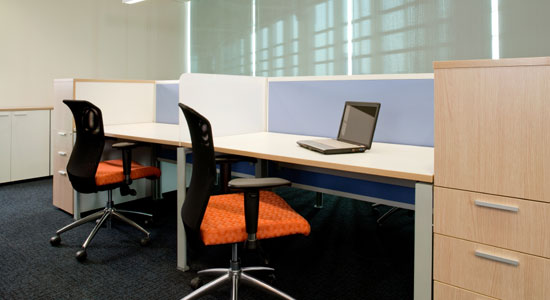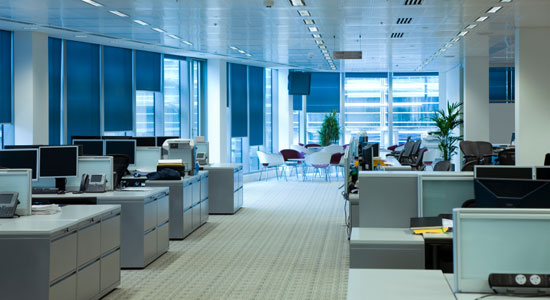How functional is your workspace at work? At home? Whether they're stuck in a time warp, distracting, or just plain depressing, many workspaces around the nation aren't exactly boosting productivity. The classic cubicle and the corner office alike may be doing a disservice to the modern-day worker, making it harder and more expensive to get work done — but it doesn't have to be that way. There are some fundamental problems with many office spaces that can be addressed by architects, designers, and even the everyday worker to help create a workspace that truly works. Read on to learn why your current setup may not be doing you any favors and to get some ideas on how you can start building a better workspace.

-
They don't reflect the type of work being done
A cubicle or a small desk might be great for certain types of work, but may actually get in the way of doing other types. If your work is collaborative, requires a lot of space, or is best done with multiple screens, and your workspace doesn't reflect this, productivity is going to be adversely affected. Unfortunately, many offices don't always take into account the different types of work done by employees and stick everyone with the same desk regardless of position.
-
They're stuck in the past
The average office space hasn't changed much over the past few decades. Things are still arranged in much the same way, people work in the same small spaces, and the average setup really hasn't changed all that much. While office spaces haven't changed, how we work has, especially when it comes to technology. This disconnect between the needs of the modern worker and the standard work setup makes many workspaces impractical and an obstacle to actually getting things done.
-
They're uncomfortable
While ergonomics has become a pretty common office concern, not all workspaces reflect good design, and some are downright uncomfortable. Common causes of discomfort include unsupportive chairs, too much reaching, and tech that isn't at the correct level. This inattention to comfort can have a bigger impact than some realize, making it painful (literally) to come in to work.
-
They don't take into account life outside of work
While ideally we'd be able to shut out the outside world and our lives at home while we're at work, the reality is that work and home life overlap more than we'd like to admit (and very often work bleeds into home life, too). Workspaces, whether at home or in the office, need to take that into account, though many do not. Workspaces that make it possible to take care of personal tasks or bring work home easily are by far the most functional and practical in the modern world.
-
They aren't flexible
Do you do the same thing every day at your job? Do you only do one task? While that might apply to some people, most of us do work that demands very different tasks from day to day. Unfortunately, most workspaces don't reflect the need for this flexibility. For instance, making calls, writing reports, and meeting with clients all require a different setup to really work.

-
They create a distracting environment
Whether you get distracted by talking with coworkers, trying to get your chair to stop squeaking, or just daydreaming about your upcoming vacation, workspaces can be very distracting places and most aren't set up to maximize concentration by all employees. Allowing the use of headphones, limiting internet access (even in your home office), and having set hours for meet-ups can all help make a workspace more efficient.
-
They don't reflect balance
Your workspace is about work, but it should also reflect who you are and your life outside of work. While you might think that honing in on only work-related things would make you more productive, that's not always the case. It can be a great break for your brain to have personal items around your desk, things that calm you, or even a few snacks when you're feeling peckish.
-
They don't flow
Most of us work our best when we get into a rhythm, almost getting lost in a project or assignment. Yet workspace design isn't always smart about helping us keep that fluidity going, creating obstacles to getting things done, making it hard to work together, and sometimes just not being high enough quality to get the job done.
-
They're chronically disorganized
Disorganization won't do you any favors when it comes to getting things done at work. You may spend several minutes every day looking for the right files and papers you need to complete an assignment, or not be able to find them at all. Creating a workspace that allows for easy organization is essential, whether you work in an office or from your home.
-
They're inefficient
Why spend more time working on a task than you have to? Your workspace may be contributing to it taking much longer than necessary to get something done by being arranged in a highly inefficient manner. Ideally, everything you need to do your job should be on hand, easy to reach, and set up in a way that doesn't put too much stress on your body. Efficiency can also play a role in your larger workspace setup, as people who need to work together or share tasks must have an easy way to communicate, share, and work on projects.

-
There's too much useless tech
Having the latest technology in your workspace can be great, but is it all really necessary to get your work done? Sometimes technology, however cool it may be, may actually slow down the process and make it more annoying to get things done on a daily basis. Evaluate your own workspace to see what tech fat can be trimmed from the setup. On the flip side, for some professions, technology may make a set workspace unnecessary, as work can better be done at home or on the road.
-
They put necessary items out of arm's reach
Do you have to walk halfway across your office to get to the printer? You're not alone. Many workspaces make it hard to get work done by constantly interrupting your flow, putting things you need to do your job in inconvenient or impractical locations. It might sound strange, but it happens more than you think.
-
They don't promote collaboration
No man is an island, and no one worker can tackle an entire project by his or herself. In many cases collaboration is necessary, but the classic cubicle setup doesn't really reflect the need to work together. Open tables and a more free-form setup might be much more practical in fields where working together is an essential part of the workday.
-
They're one size fits all
What works for one person may not work for another, a statement that's true in just about everything in life, including workspaces. The average workspace doesn't allow for much individualization, creating cookie-cutter setups and layouts that might not fit every person or every kind of job.
-
They're not inspirational
It's hard to want to do anything, from designing a logo to filling out forms, if your workspace is a dour and gloomy place to be. This isn't to say that every workspace needs to be bright, new, and cheerful to aid in productivity, as there are many ways to create an inspirational workspace. Sometimes, even something as simple as having a photo of a vacation spot, a pet, or loved ones can be inspirational. Of course, a fantastic architectural setting doesn't hurt either. No matter the circumstances, the ideal workspace should be somewhere that employees like being, whether that means making it more comfortable, adding personal accents, or providing motivation on-site. Many current workplaces are dull and impersonal, making it hard to get excited about doing anything in them.
No comments:
Post a Comment